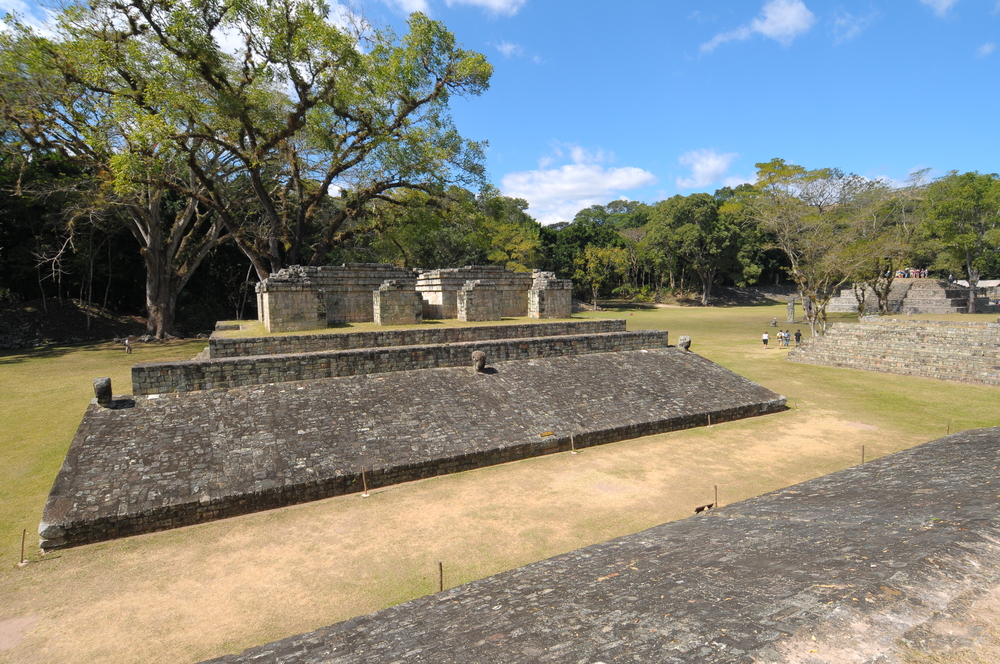Copan: Maya Ruins in Honduras

Copan is an ancient Maya city, located in modern-day western Honduras. It was ruled by a dynasty of 16 kings between roughly A.D. 426 and 820.
The city’s ancient name may have been Oxwitik and its official emblem was in the shape of a bat. The city’s core covered only about 37 acres (150,000 square meters), and archaeological work shows that it was remodeled and rebuilt continuously over a period of 400 years. In its final form, it contained a great plaza to the north and a built-up “acropolis” to the south.
Located on the southeastern periphery of the Maya world, the city was spared some of the warfare that ravaged its larger and more centrally located neighbors. Nevertheless, the kings of the city were depicted as warriors, and hostilities with the neighboring city of Quirigua led its unlucky 13th ruler, Waxaklahun Ubah K’awil, to be captured and sacrificed.
The city was one of the most densely populated in the Maya world, and its people built great monuments and sculptures out of a greenish volcanic tuff. Among the monuments they constructed was the “Temple of the Hieroglyphic Stairway.” It’s a pyramid-like structure that has more than 2,000 glyphs embellished on a flight of 63 steps, the longest ancient Maya inscription known to exist.
Since “most of it was found in extremely jumbled condition, it is far from easy to reconstruct,” writes Yale University professor Michael Coe in his book "The Maya" (Thames and Hudson, 2011). From what scholars have deciphered, it appears to tell the history of Copan’s rulers.
Further evidence of Copan’s history comes from its numerous steles and altars. One important monument, called “altar Q” by archaeologists, was built by Yax Pasah, the last of the city’s kings, and tells of the 15 rulers who came before him. It shows Yax Pasah receiving the baton (or scepter) of office from Copan’s first king, a revered man named K’inich Yax K’uk Mo’.
The origins of a dynasty
K’inich Yax K’uk Mo’ appears to have been a foreigner who arrived at Copan and, through unknown circumstances, eventually became its first recorded king, perhaps taking a prominent local individual as his wife.
Get the world’s most fascinating discoveries delivered straight to your inbox.
Archaeologists have discovered what they believe to be his tomb beneath the pyramid shaped “temple 16” (as it’s called by researchers). The tomb “contains the remains of an adult male on a funerary slab accompanied by extensive jade, shell, ceramic and worked bone offerings,” a team of researchers writes in a paper published in the book "Understanding Early Classic Copan" (University of Pennsylvania Museum of Archaeology and Anthropology, 2004).
They write that the male was between 55 and 70 years old when he died, and Coe notes that isotope tests (which can detect where a person lived early in their life) show that he was not from Copan and might have been from another city, perhaps Tikal.
Not far away is another tomb that contains the remains of a female in her 50s, possibly his wife. In addition to an array of offerings “the skeleton was embedded in massive amounts of cinnabar, and the bones appear to have been painted with a cinnabar solution or slurry,” writes the research team. Coe notes that isotope tests done on the remains suggest that the woman was from the local area.
Putting this research together a picture emerges of a person from another city (perhaps Tikal) coming to Copan, marrying a prominent local woman, and founding a ruling dynasty. Coe notes that, in addition, some of the artifacts found with this couple have motifs associated with Teotihuacan, a city located almost 700 miles (1,200 kilometers) to the northwest, suggesting influence from there.
Archaeology also reveals that construction at Copan’s city center picked up around the time K’inich Yax K’uk Mo’ became king. Another team of researchers writes that “we date the beginnings of monumental construction beneath the Acropolis at ca. A.D. 400,” in a paper published in the book "Copan: History of an Ancient Mayan Kingdom" (School of American Research Press, 2005). A period of deforestation may have coincided with this building boom.
Successors to K’inich Yax K’uk Mo’ included a number of short-lived rulers, which suggests that kingship may have passed between brothers, at least in the early days of Copan.
The city center
Throughout the next 400 years, the city center changed, with structures being added, remodeled and built over.
The great plaza could have held a large portion of Copan’s population during special events. Research reveals that the population of the city and nearby areas peaked at about 26,000 people around A.D. 750, writes David Webster, AnnCorinne Freter and Nancy Gonlin in their book, "Copan: The Rise and Fall of an Ancient Maya Kingdom" (Harcourt Brace and Company, 2000).
Construction of the Temple of the Hieroglyphic Stairway was started by Copan’s 13th ruler (the one who was captured and sacrificed) and was finished by its 15th, a ruler named “Smoke Shell,” who ascended to the throne in A.D. 749. Coe notes that it was completed “with a strange ‘bilingual’ inscription, one part Maya, and the other a matching text in what some local artist must have imagined to be Teotihuacan hieroglyphs.”
Copan also included a ball court, which was remodeled throughout time, the final form having “tenon sculptures in the shape of macaw heads as its markers,” Coe writes. How scoring worked during a ball game on this court is a mystery.
Another key structure, also built by the ill-fated 13th ruler, is known as “structure 22.” Researcher Jennifer Ahlfeldt writes in a 2003 research report that “since the late 19th century, archaeologists have excavated over 4,000 pieces of sculpture from around this building.” Her research suggests that it was used as a throne room by Copan’s rulers. “It was here that the ruler was transformed into, and subsequently dwelled as, a deity,” she writes in a 2005 report.
Where there was a royal throne room there was a royal residence. On the south of the acropolis is a group of buildings called “10L-2” by archaeologists and “after about A.D. 600, it apparently functioned as the royal residential enclave where rulers, their close relatives, and retainers, all actually lived most of the time,” write Webster, Freter and Gonlin in their book.
End of Copan
The last king of Copan was Yax Pasah, who ascended to the throne in A.D. 763 and reigned into the 9th century when the city’s governance became increasingly unstable. “According to some inscriptions other Copan nobles, including possible relatives of Yax Pasah, became politically assertive in the early 9th century,” write Webster, Freter and Gonlin.
“None, however, was able to stave off the abrupt end of dynastic rule, signalled by the last, uncompleted royal monument dated to A.D. 822.” The researchers note that sometime after A.D. 850, the royal residence was “deliberately burned” and in the centuries that followed, Copan became depopulated for reasons that scholars still debate.
Copan was not alone in its plight. Cities throughout the Maya world were falling, and one possibility is that a great drought hit the Maya. Webster, Freter and Gonlin also note that their studies show that the Copan’s peak population of 26,000 people may have been unsustainable, forcing them to cultivate marginal lands. Copan, like many other Maya cities, faded away.
Rediscovery
After the Spaniards landed in the Americas, an event happened that resulted in the ruins getting its modern-day name. In “1530, a local chief called Copan Calel led an uprising against the Spanish; after his defeat his name became attached to the ruins,” write Webster, Freter and Gonlin.
The Spaniards took note of the ancient city but it wasn’t until the 19th century that it was thoroughly explored. In 1839, explorer Frederick Catherwood drew detailed drawings of parts of the city, including an altar and stela in Copan’s great plaza. His colorful, detailed, drawings of Copan showed trees growing everywhere among its ruins.
— Owen Jarus, LiveScience Contributor

Owen Jarus is a regular contributor to Live Science who writes about archaeology and humans' past. He has also written for The Independent (UK), The Canadian Press (CP) and The Associated Press (AP), among others. Owen has a bachelor of arts degree from the University of Toronto and a journalism degree from Ryerson University.



